Study on the Improvement of Coastal Pumping Station Inlet Flow Regime and Evaluation of Transverse Flow Velocity Elimination
Abstract
1. Introduction
2. Numerical Calculation Model Design
3. Experimental System
3.1. Introduction to Experimental Model
3.2. Experimental Parameters
3.3. Experimental Methods
- Particles of potassium permanganate mixed with sand were applied to the surface of the forebay to visualize the flow occurring at the bottom.
- Flow velocity at the inlet channel’s front was recorded using a velocimeter under different conditions. The collected data were analyzed to determine the distribution of transverse flow velocity in front of the pumping station’s inlet channel.
4. Numerical Methods and Verification
4.1. Flow Governing Equations
4.2. Boundary Conditions
4.3. Grid Meshing and Grid Independence Analysis
5. Results and Discussions
5.1. Analysis of Numerical Simulation Results
5.1.1. Flow Field Analysis
5.1.2. Flow Uniformity Analysis of Inlet Channel
5.1.3. Analysis of Transverse Flow Velocity
5.2. Analysis of Model Test Results
5.2.1. Flow Field Analysis
5.2.2. Analysis of Transverse Flow Velocity
5.3. Discussion
6. Conclusions
- (1)
- During asymmetric operation of large coastal low-head pump stations, hydraulic phenomena such as bias flow and stagnant water may occur in the forebay. The inflow direction at the channel inlet becomes inclined, resulting in a significant transverse flow velocity. With fewer operating units, the transverse flow at the channel inlet becomes more pronounced, which can easily lead to the formation of an air vortex at the inlet channel, thereby affecting the safe and stable operation of the pump units.
- (2)
- Numerical simulation results have demonstrated the feasibility of using multiple indicators to evaluate the flow regime of pumping stations under different operating conditions. Comprehensive evaluation indicators provide a more reasonable assessment of the operational status of pump stations. The optimal configuration for the partition wall is as follows: the width of the partition wall is 1.2 m, and the length is 2L (where L is the inlet width of the channel). Compared to the initial arrangement, during asymmetric operation, the average uniformity of flow velocity distribution in the left opening of the inlet channel of each unit increased by 5.11%, and the average elimination rate of lateral flow velocity before the inlet reached 52.85%. During the operation of the entire unit, the uniformity of flow velocity distribution in the left and right openings of each inlet channel increased by 1.75%, and the lateral flow velocity before the inlet was reduced by 39.55%. Therefore, the optimized pump station forebay meets the operational requirements of the project.
- (3)
- Physical model experiments can verify numerical simulation results. The experiment results of the inlet flow regime and transverse flow velocity at the inlet of the pump station under different partition wall configurations obtained from hydraulic model experiments, as well as their influence patterns, are consistent with the numerical simulation results. Under various operational conditions, the relative errors between the numerical simulation results and the model test results for the transverse velocity elimination rate at the inlet of each channel are all less than 7.0%.
- (4)
- In the next stage, this study will further consider the rectification effect under different working conditions of the pump station to ensure safe and stable operation with different forebay diffusion angles and more units after installing the partition wall.
Author Contributions
Funding
Data Availability Statement
Conflicts of Interest
References
- Jiang, W.; Yu, J.Z.; Fu, Z.P. Flow Patterns and Rectification Measures in a Forebay of Pumping Station Designed at Bend River. Yellow River 2019, 41, 83–87+118. [Google Scholar]
- Lu, Y.J.; Zhou, W.; Ming, Y.M. Layout design optimization of integrated pumping station and sluice with numerical stream simulation. J. Drain. Irrig. Mach. Eng. 2014, 32, 963–967. [Google Scholar]
- Huang, X.B.; Xi, C.N.; Dong, Z.H. Control methods of air-entrained vortex of intake. J. Irrig. Drain. Eng. 2024, 42, 657–662. [Google Scholar]
- Shi, W.; Lv, F.; Yu, X.; Wang, X.; Ni, C.; Lu, W.; Xu, L. Influence of Partition Wall Length on Inlet Flow Regime of a Pumping Station Arranged in Parallel with a Sluice Gate. Processes 2024, 12, 699. [Google Scholar] [CrossRef]
- Xu, W.T.; Cheng, L.; Du, K.L. Numerical and experimental research on rectification Measures for a contraction diversion pier in a pumping station. J. Mar. Sci. Eng. 2022, 10, 1437. [Google Scholar] [CrossRef]
- Xu, B.; Xu, S.P.; Xia, H. Optimal Design of Perforated Diversion Wall Based on Comprehensive Evaluation Indicator and Response Surface Method: A Case Study. Processes 2023, 11, 1539. [Google Scholar] [CrossRef]
- Yan, Z.Q.; Gu, J.D.; Zhao, J.J. Experimental study on hydraulic performance Optimization of pump house with ultra-short forebay. J. Phys. Conf. Ser. 2021, 2044, 12020. [Google Scholar]
- Bai, Y.C.; Li, B.; Xu, H.Y. Rectifying analysis of multi-herringbone diversion piers scheme for large span pumping station in forebay. Water Resour. 2019, 37, 75–79. [Google Scholar]
- Zhang, C.; Yan, H.; Jamil, M.T. Improvement of the Flow Pattern of a Forebay with a Side-Intake Pumping Station by Diversion Piers Based on Orthogonal Test Method. Water 2022, 14, 2663. [Google Scholar] [CrossRef]
- Liu, M.Q.; Lin, Q.; Liang, X. Numerical simulation research on improving flow pattern of forebay of a pumping station. J. Wuhan Univ. 2012, 45, 152–156. [Google Scholar]
- Zhou, J.R.; Zhong, S.W.; Liang, J.D. Three dimensional numerical simulation of side-intake forebay of pumping station. J. Irrig. Drain. Eng. 2015, 34, 52–55+80. [Google Scholar]
- Li, Y.Y.; Guo, P.C.; Sun, L.G. Numerical analysis on influence of vertical column on flow pattern in forebay and intake of large pumping station. J. Irrig. Drain. Eng. 2021, 39, 929–936. [Google Scholar]
- Xu, R.L.; Xu, L.; Lu, L.G. Optimum design of rectifying flow of column array in pressure forebay with extra-large diffusion angle of a pumping station. Water Resour. Hydropower Eng. 2021, 52, 134–145. [Google Scholar]
- Xia, C.Z.; Cheng, L.; Jiao, W.X. Nurnerical simulation on rectification measure of inverted T-shaped sill at forebay of pump station. South–North Water Transf. Water Sci. Technol. 2018, 16, 146–150+163. [Google Scholar]
- Xi, W.; Lu, W.G.; Wang, C. Optimization of the Hollow Rectification Sill in the Forebay of the Pumo Station Based on the PSO-GP Collaborative Algorithm. Shock Vib. 2021, 2021, 6618280. [Google Scholar]
- Xu, B.; Lv, H.P.; Xia, H. Influence of Trapezoidal sills on flow pattern in forebay of fenghuangjing new station. Water Resour. Power 2023, 41, 124–127. [Google Scholar]
- Yu, Y.H.; Yan, H.D.; Ye, C.L. Parameter optimization of rectification sill in the forebay of pumping station using BPNN-GA algorithm. Trans. Chin. Soc. Agric. Eng. 2023, 39, 106–113. [Google Scholar]
- Luo, C.; Cheng, L.; Liu, C. Numerical simulation of mechanism for sill rectifying flow in pumping station intake. J. Drain. Irrig. Mach. Eng. 2014, 32, 393–398. [Google Scholar]
- Song, W.W.; Pang, Y.; Shi, X.H. Study on the Rectification of Forebay in Pumping Station. Math. Probl. Eng. 2018, 2018, 2876980. [Google Scholar]
- Yang, F.; Zhang, Y.Q.; Liu, C. Numerical and Experimental Investigations of Flow Pattern and Anti-Vortex Measures of Forebay in a Multi-Unit Pumping Station. Water 2021, 13, 935. [Google Scholar] [CrossRef]
- Han, F.; Liang, J.D. Numerical Simulation and Improvement for Flow Pattern in Forebay of One-way Inflow Pumping Station. China Rural. Water Hydropower 2018, 8, 190–193. [Google Scholar]
- Feng, J.G.; Wang, X.B.; Cheng, B. Experimental Study on the Flow Pattern Modifying in the Fore Bay of large Urban Side Inflow Pumping Stations. Procedia Eng. 2012, 28, 214–219. [Google Scholar]
- Nasr, A.; Yang, F.; Zhang, Y.Q. Analysis of the Flow Pattern and Flow Rectification Measures of the Side-Intake Forebay in a Multi-Unit Pumping Station. Water 2021, 13, 2025. [Google Scholar] [CrossRef]
- Zheng, X.B.; Zhang, P.L.; Zhang, W.J. Numerical Study on the Influence of Combined Rectification Facilities on the Flow in the Forebay of Pumping Station. Water 2023, 15, 3847. [Google Scholar] [CrossRef]
- Li, Y.; Gu, J.D.; Guo, C. Flow Patterns and Rectification Measures in the Forebay of Pumping Station. IOP Conf. Ser. Mater. Sci. Eng. 2020, 794, 012058. [Google Scholar] [CrossRef]
- Matyakubov, B.; Mamajonov, M.; Shakirov, B. Forebays of the poligonal cross-section of the irrigating pumping station. IOP Conf. Ser. Mater. Sci. Eng. 2020, 883, 012050. [Google Scholar] [CrossRef]
- Khasanov, B.; Azimov, A.; Djurabekov, A. Full-scale testing of water intake pumps of pumping stations. In E3S Web of Conferences; EDP Sciences: Les Ulis, France, 2019; Volume 97, p. 05017. [Google Scholar]
- Chae, K.J.; Kim, I.-S.; Ren, X.H. Reliable energy recovery in an existing municipal wastewater treatment plant with a flow-variable micro-hydropower system. Energy Convers. Manag. 2015, 101, 681–688. [Google Scholar] [CrossRef]
- Arifjanov, A.M.; Sattorov, A.X.; Atakulov, D. Method of calculation of the flow motion model in water intake facilities. IOP Conf. Ser. Earth Environ. Sci. 2023, 1231, 012060. [Google Scholar] [CrossRef]
- Zhu, H.G.; Xi, B. New method for pump sump hydraulic medel study. Trans. Chin. Soc. Agric. Mach. 2023, 34, 72–75. [Google Scholar]
- ANSI/HI 9.8-2018; Rotodynamic Pumps for Pump Intake Design. American National Standards Institute: Washington, DC, USA, 2018.
- Sun, D.X.; Mu, Z.W.; Li, F.Q. Experimental study on hydraulic characteristics of diversion pier combined with rough-strips energy dissipator in the bend spillway. J. Water Resour. Water Eng. 2019, 30, 166–171. [Google Scholar]
- Zi, D.; Wang, F.J.; Tao, R. Research for impacts of boundary layer grid scale on flow field simulation results in pumping station. Shuili Xuebao 2016, 47, 139–149. [Google Scholar]
- Zhou, D.F.; Wang, Y.B.; Zhou, J.R. Optimization of numerical simulation for intake sump in a sluice-pump station. Hydro-Sci. Eng. 2023, 5, 68–77. [Google Scholar]
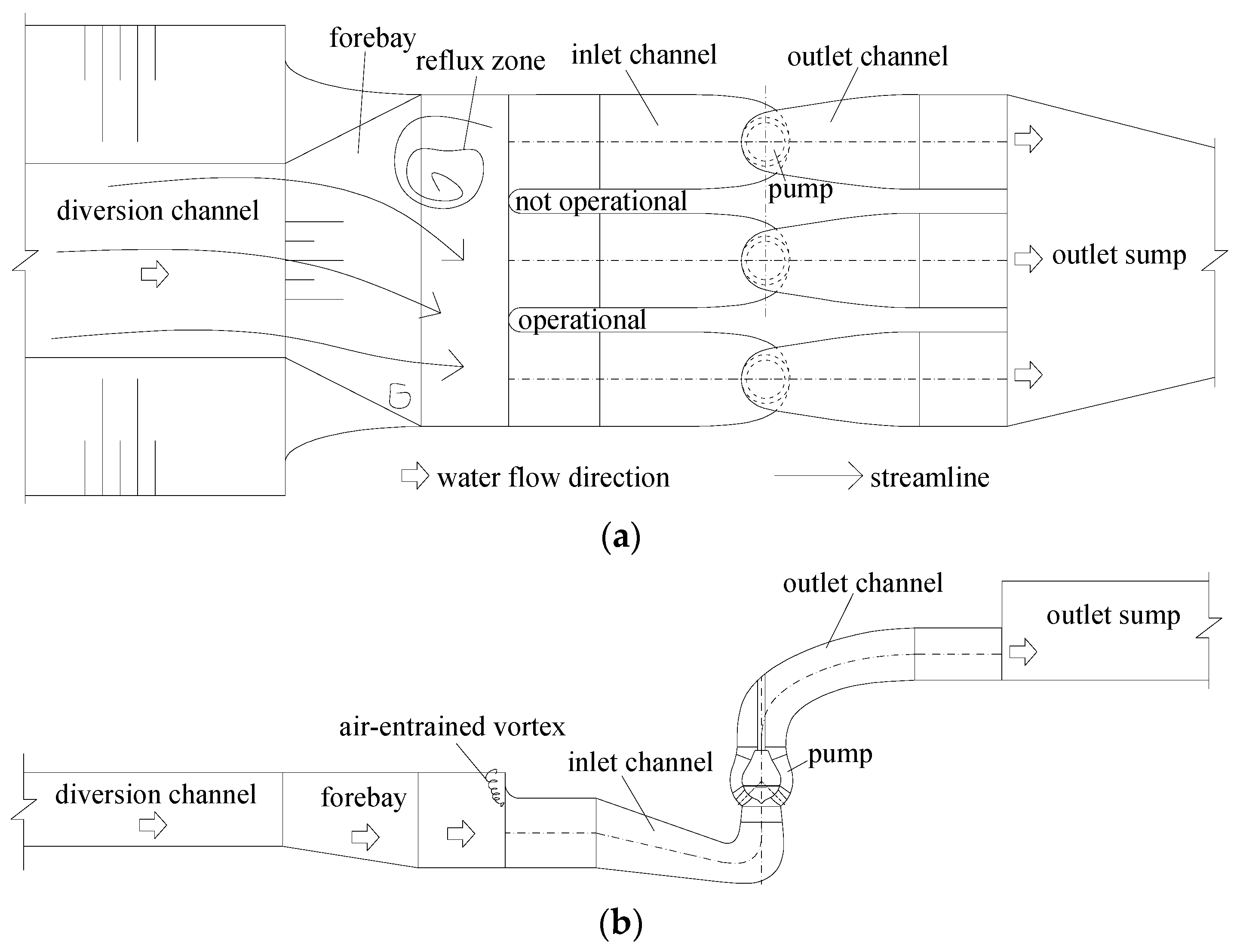
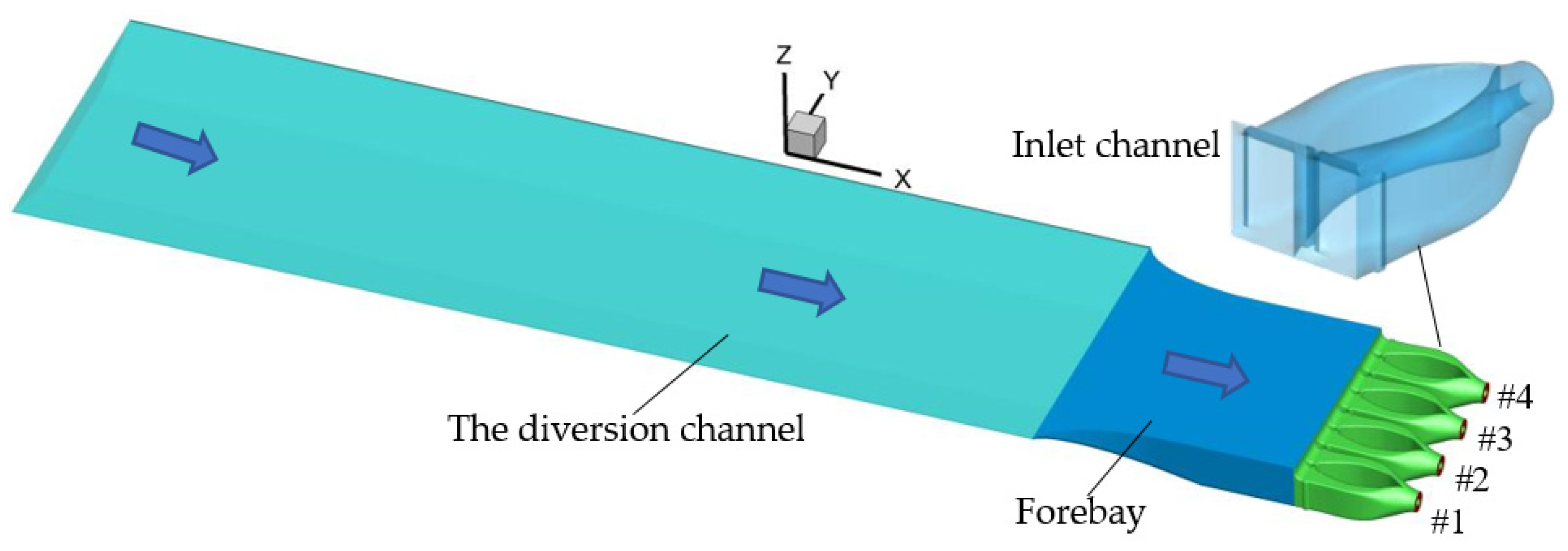
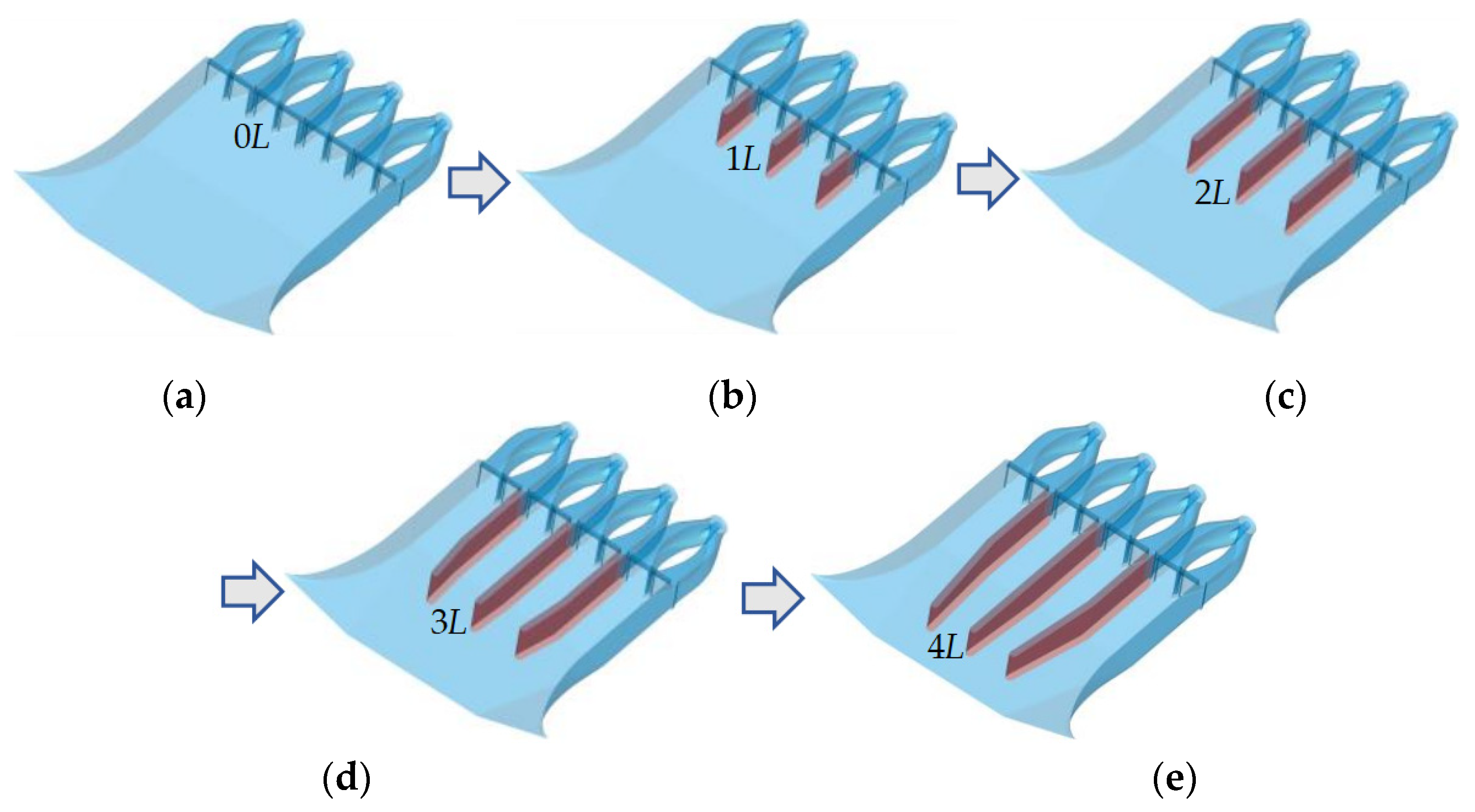

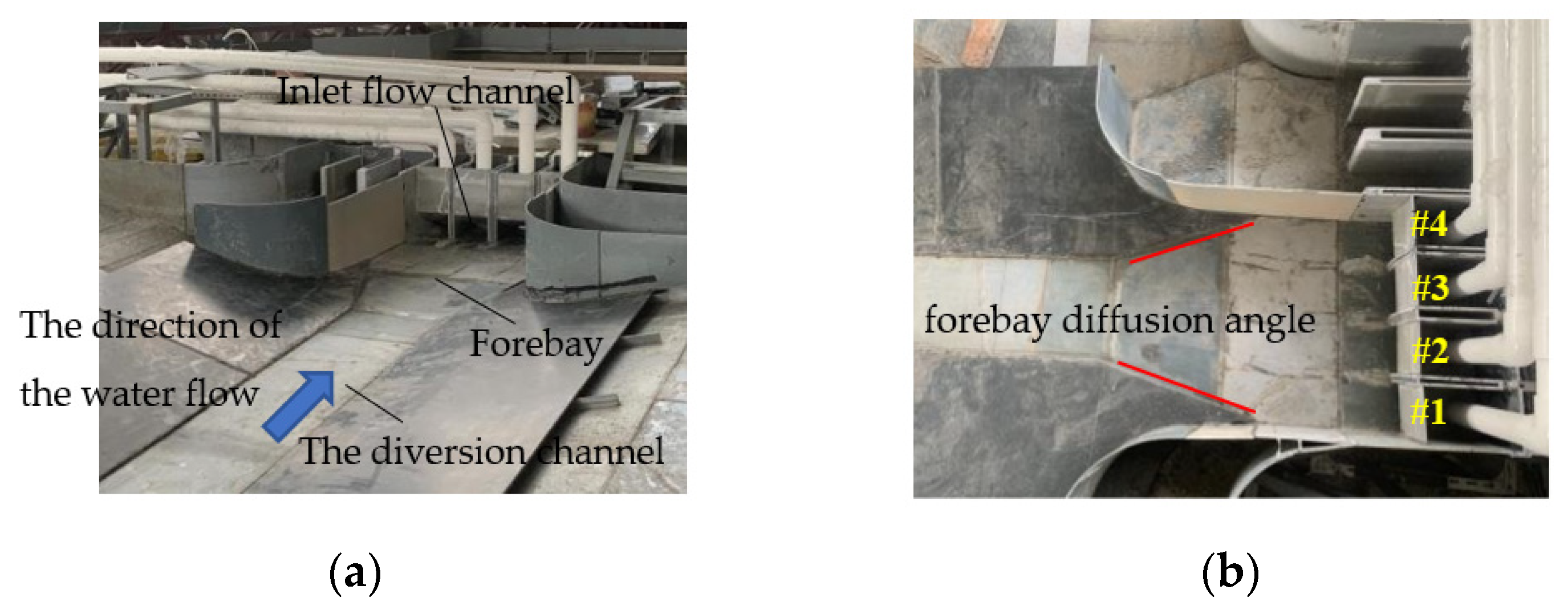
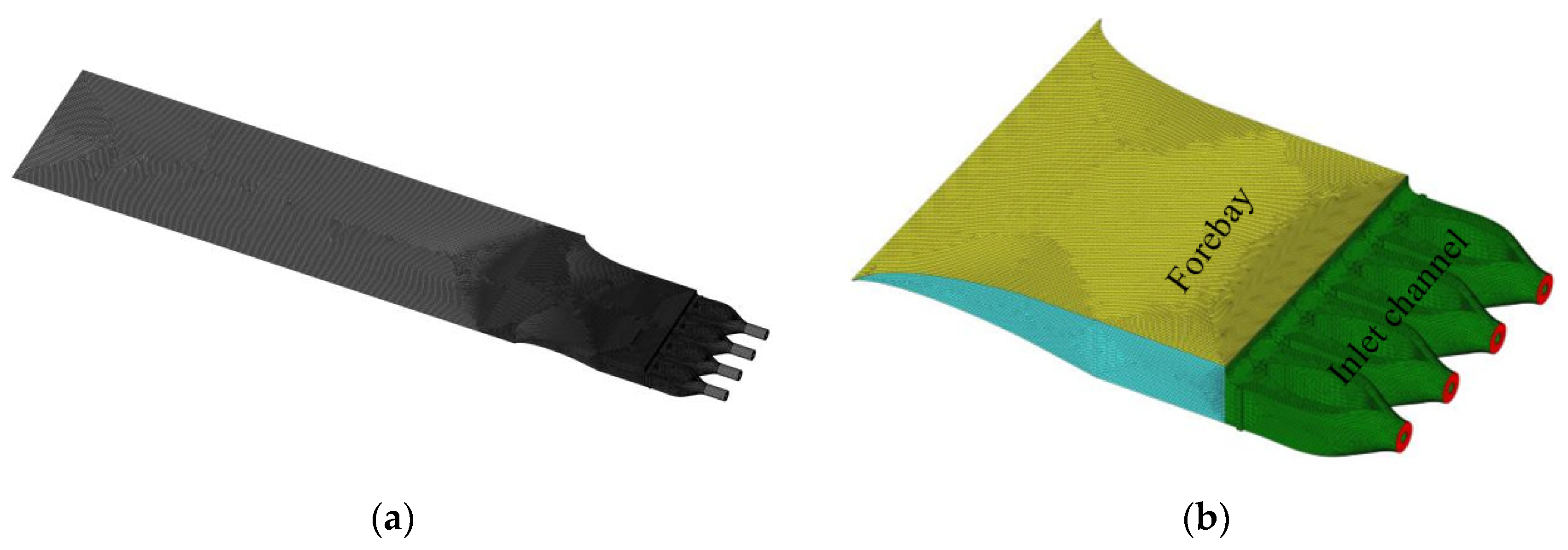
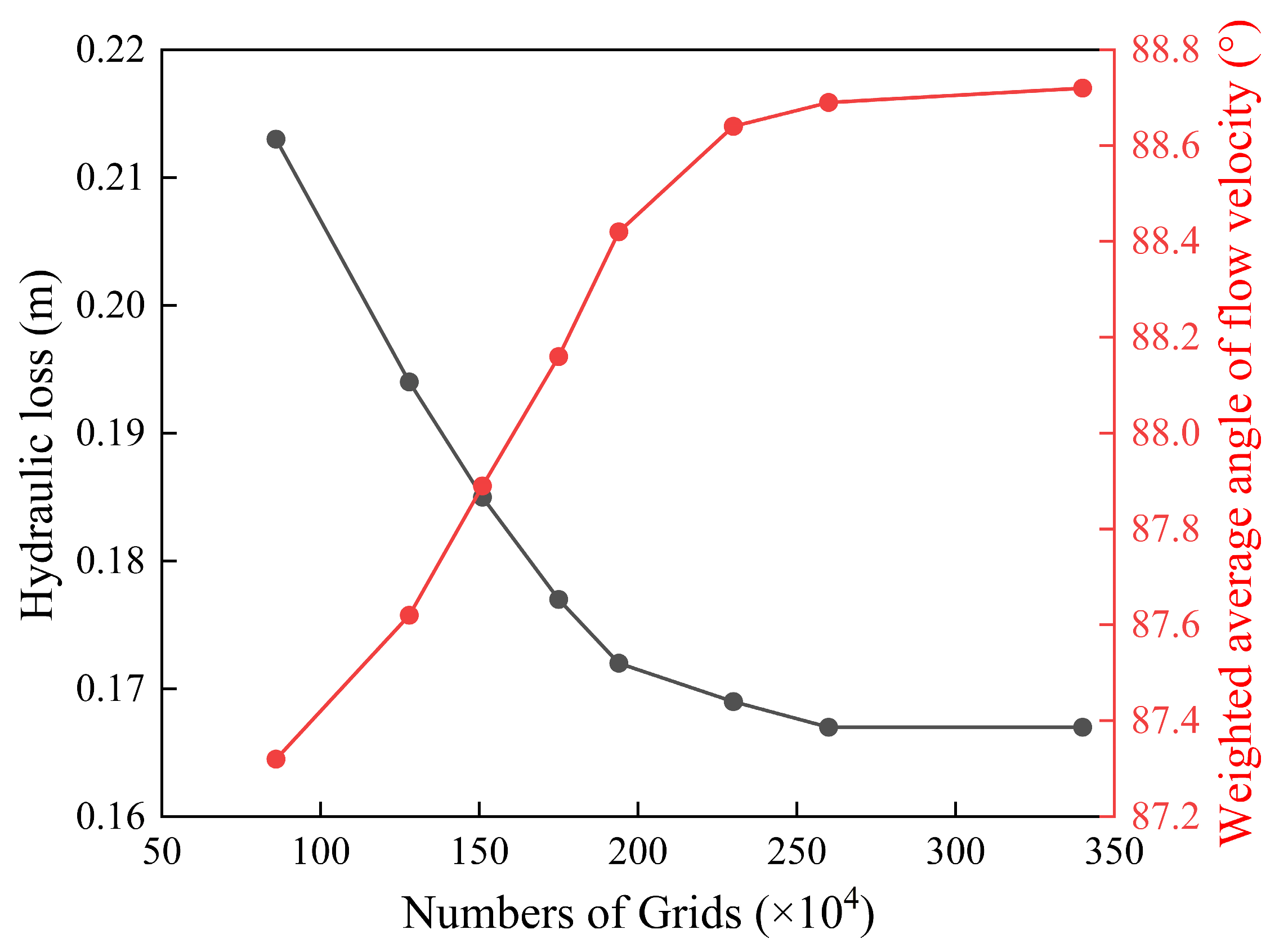
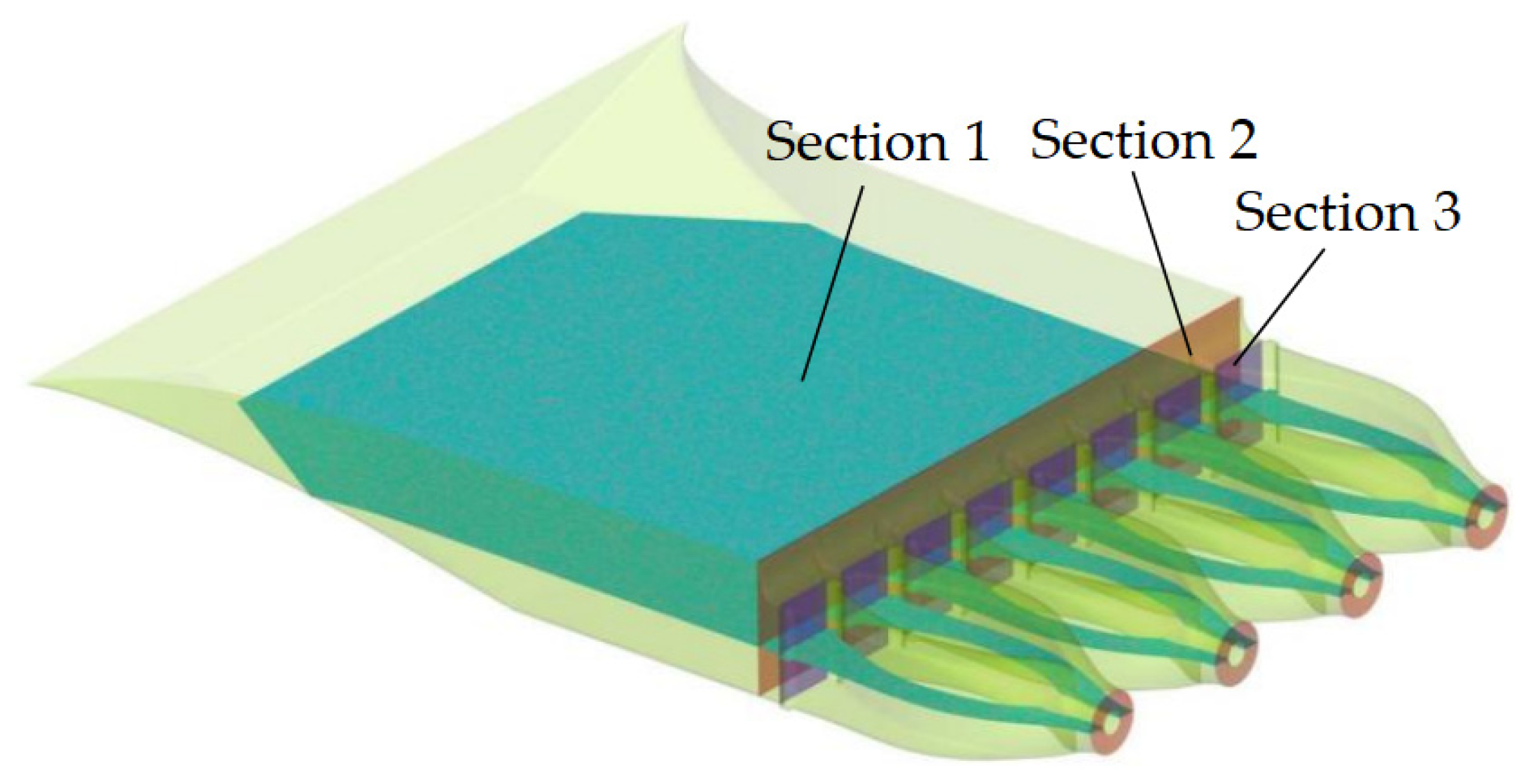
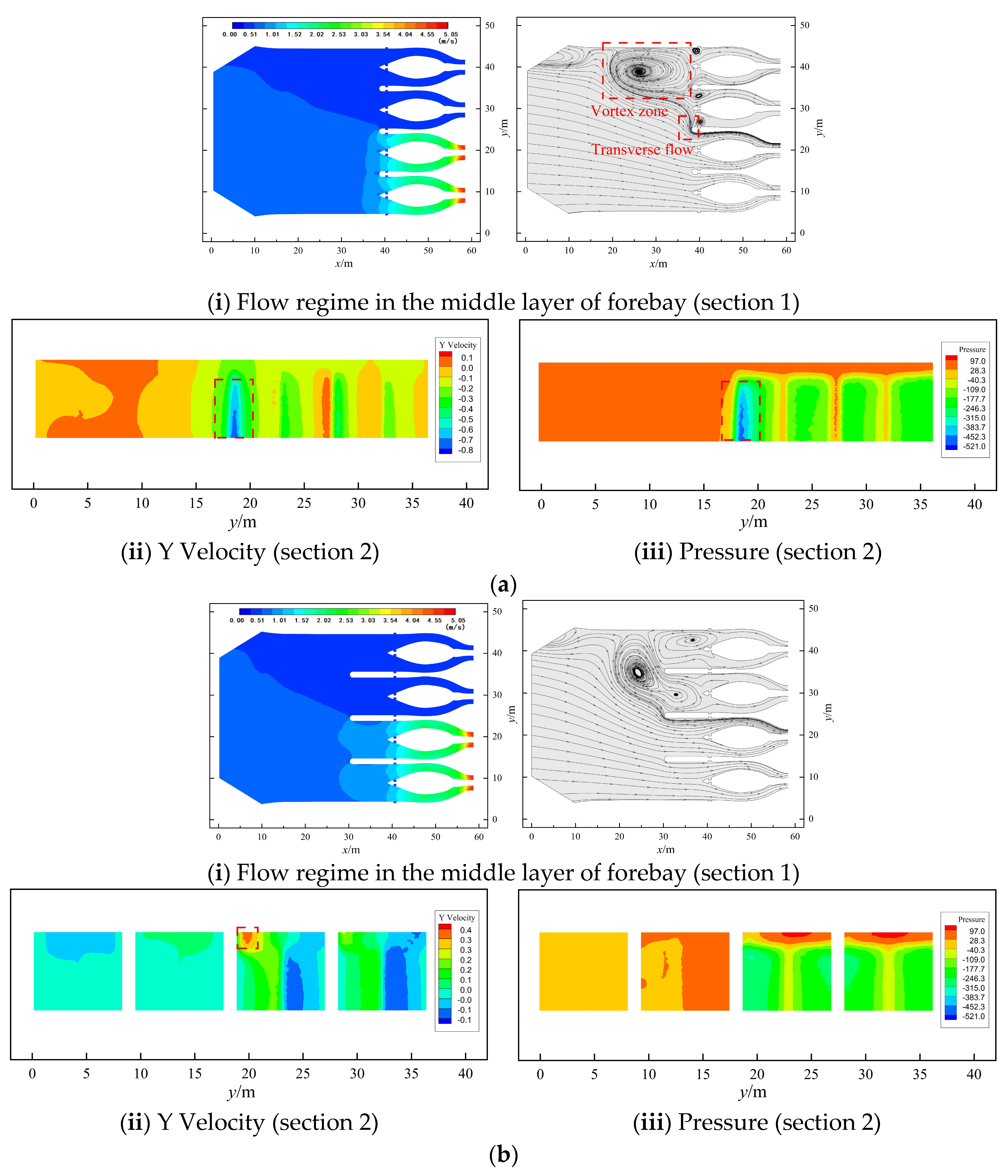
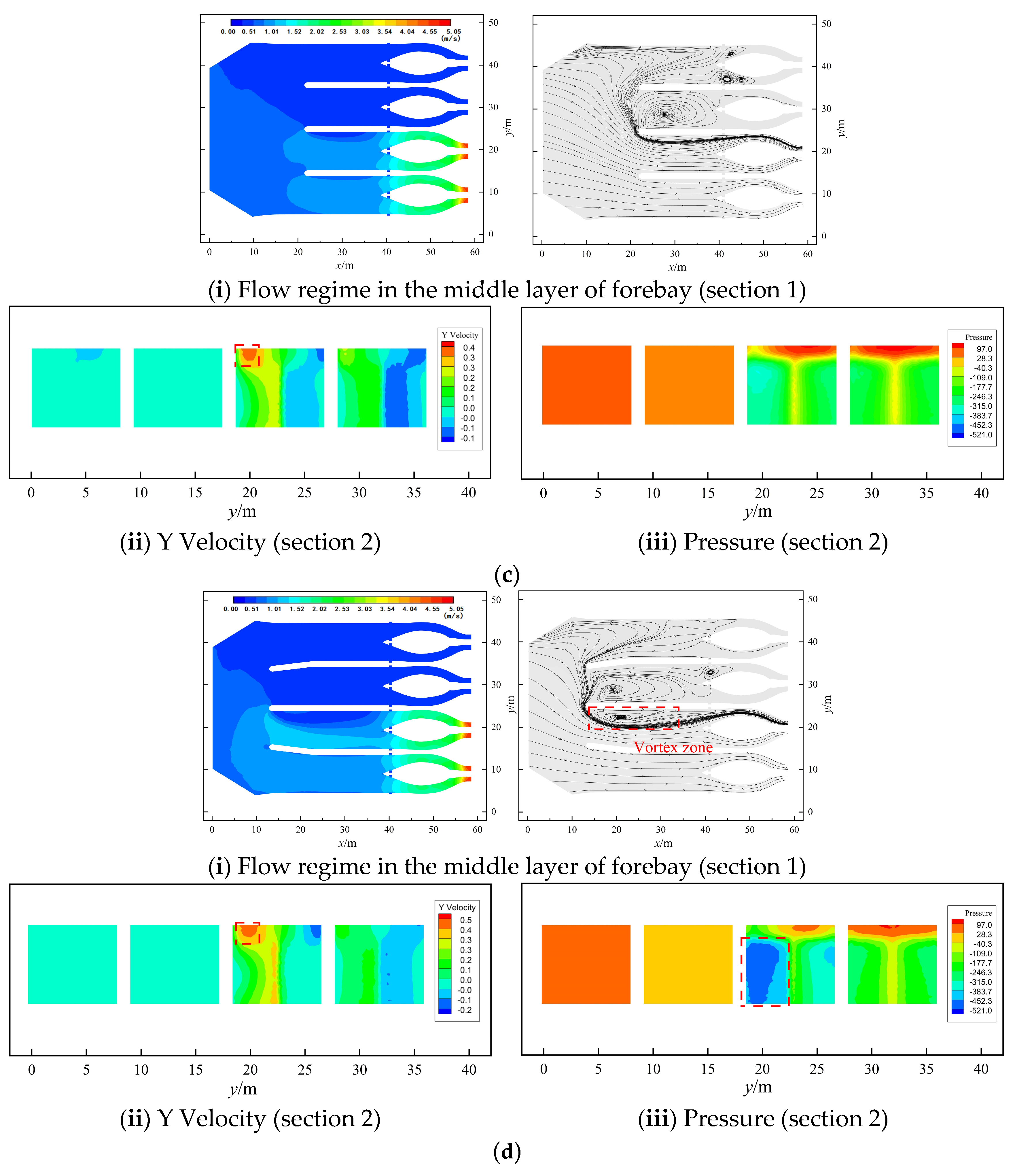



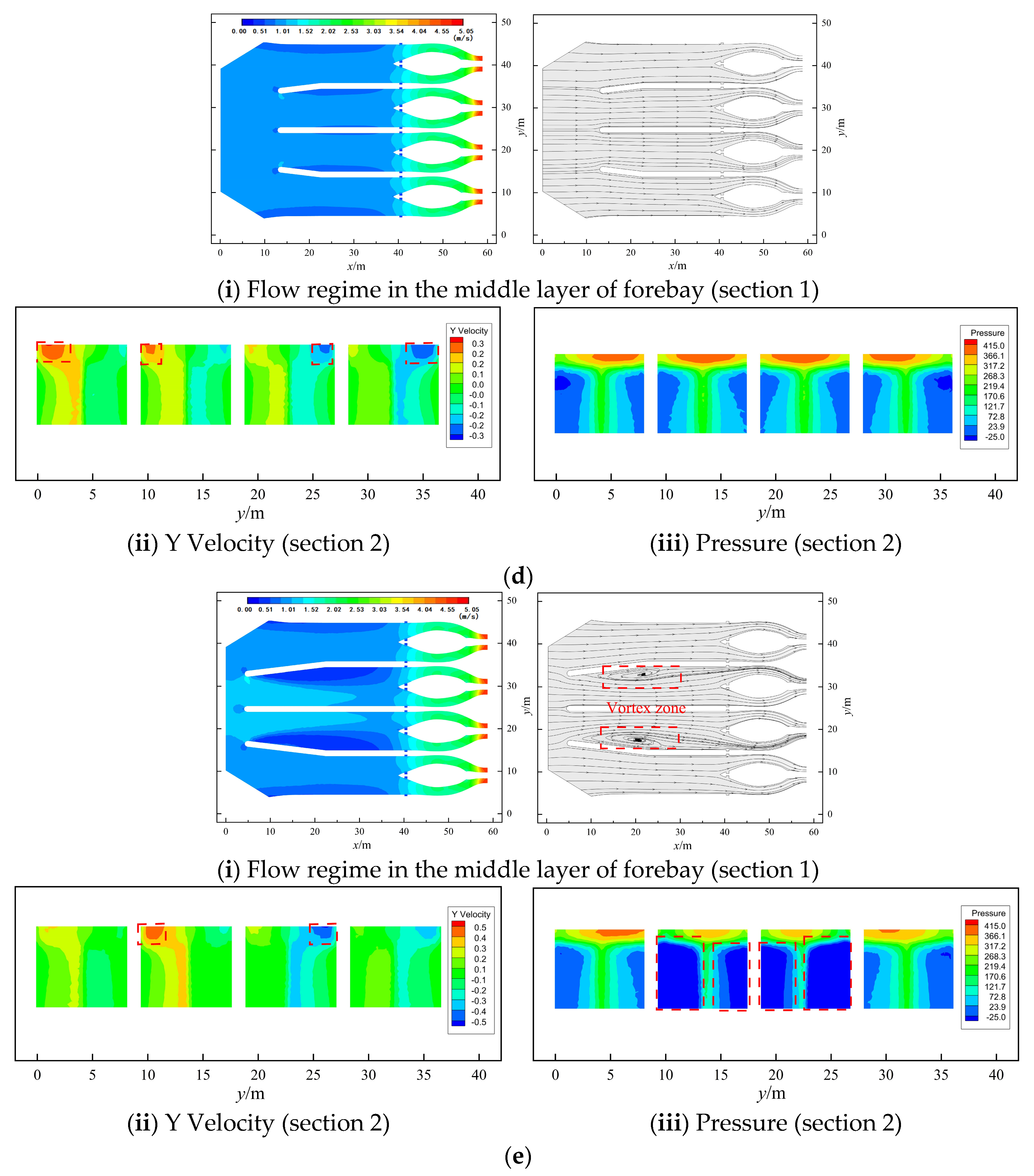

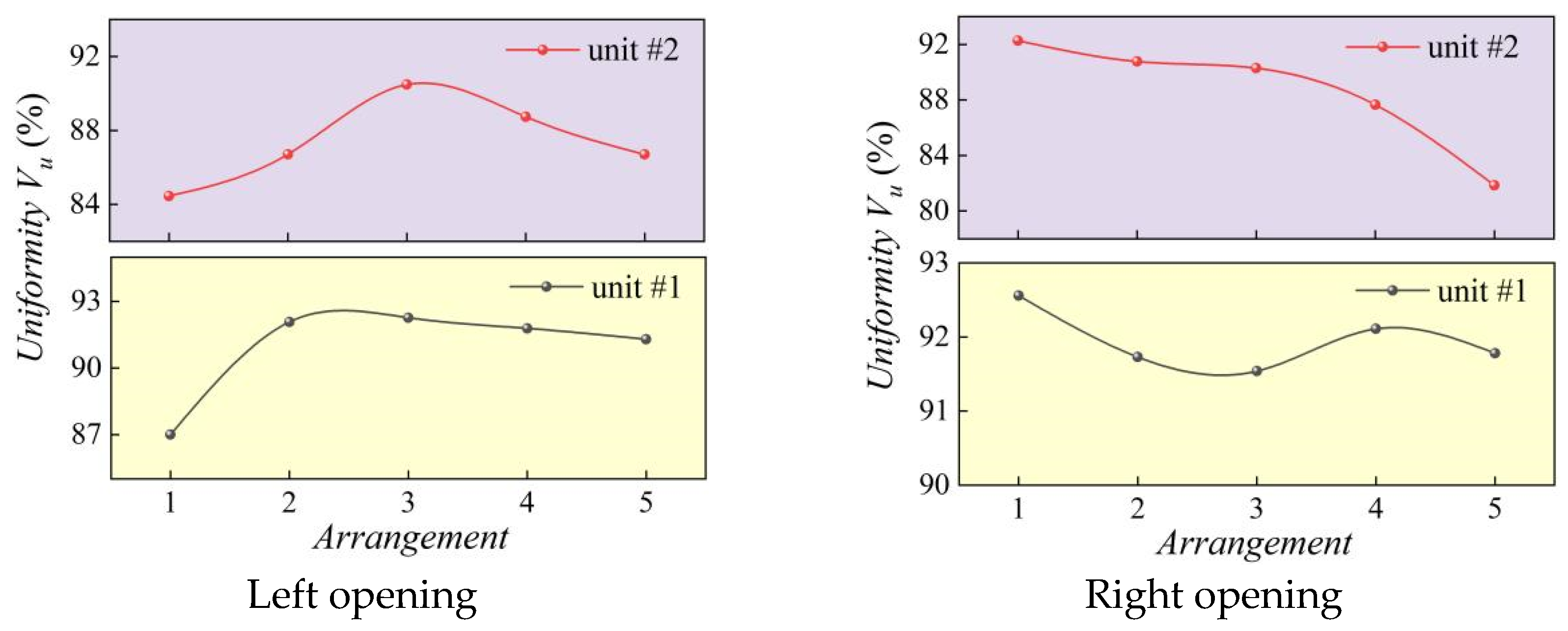

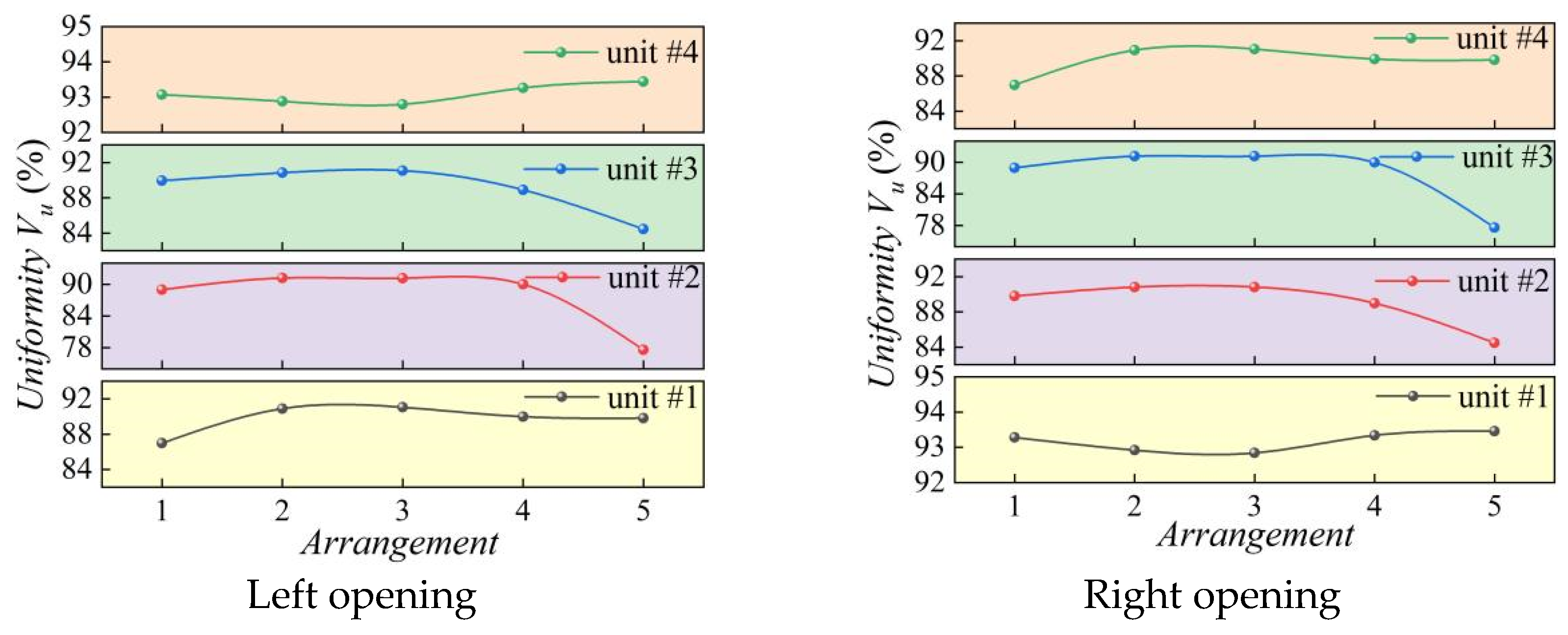

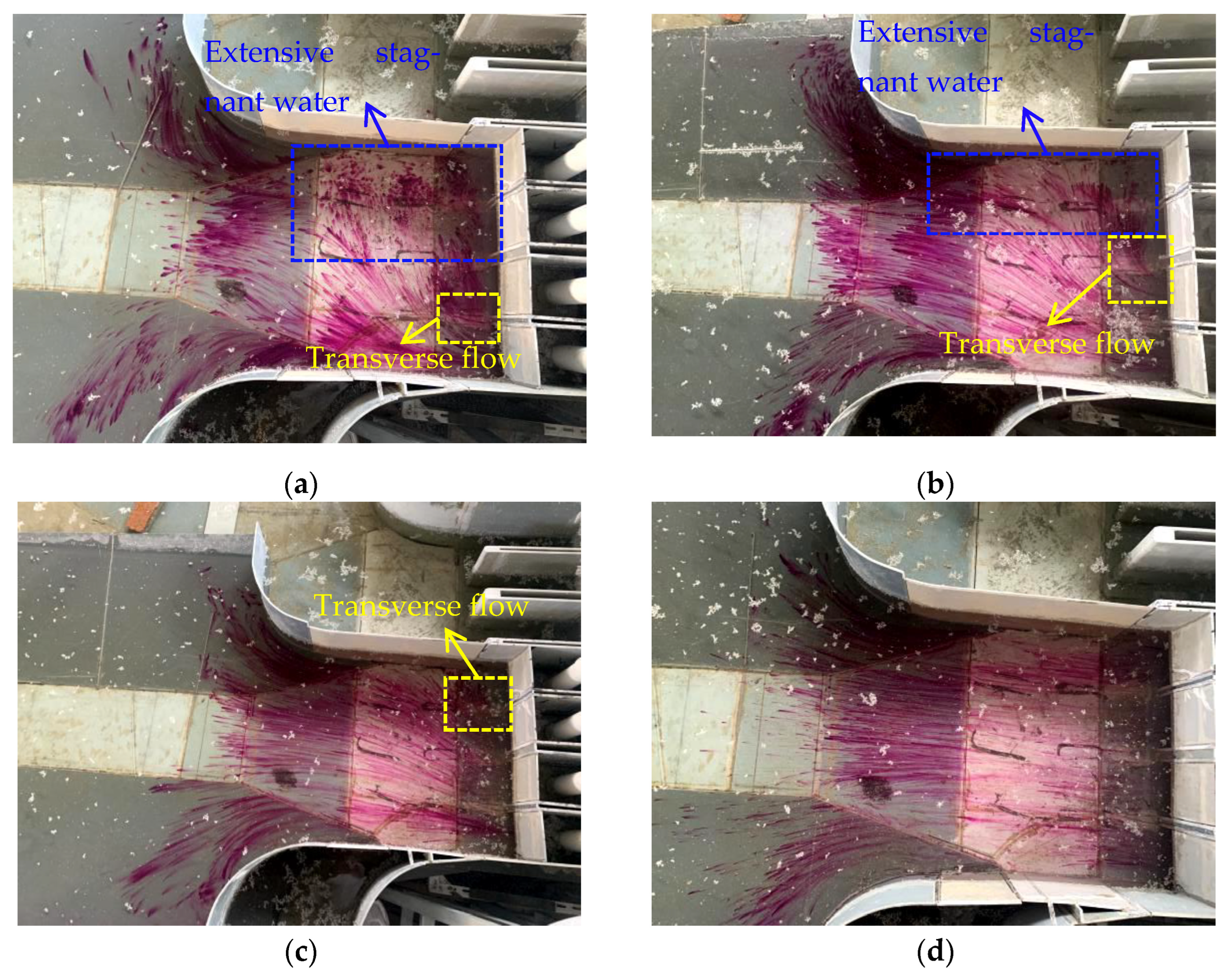
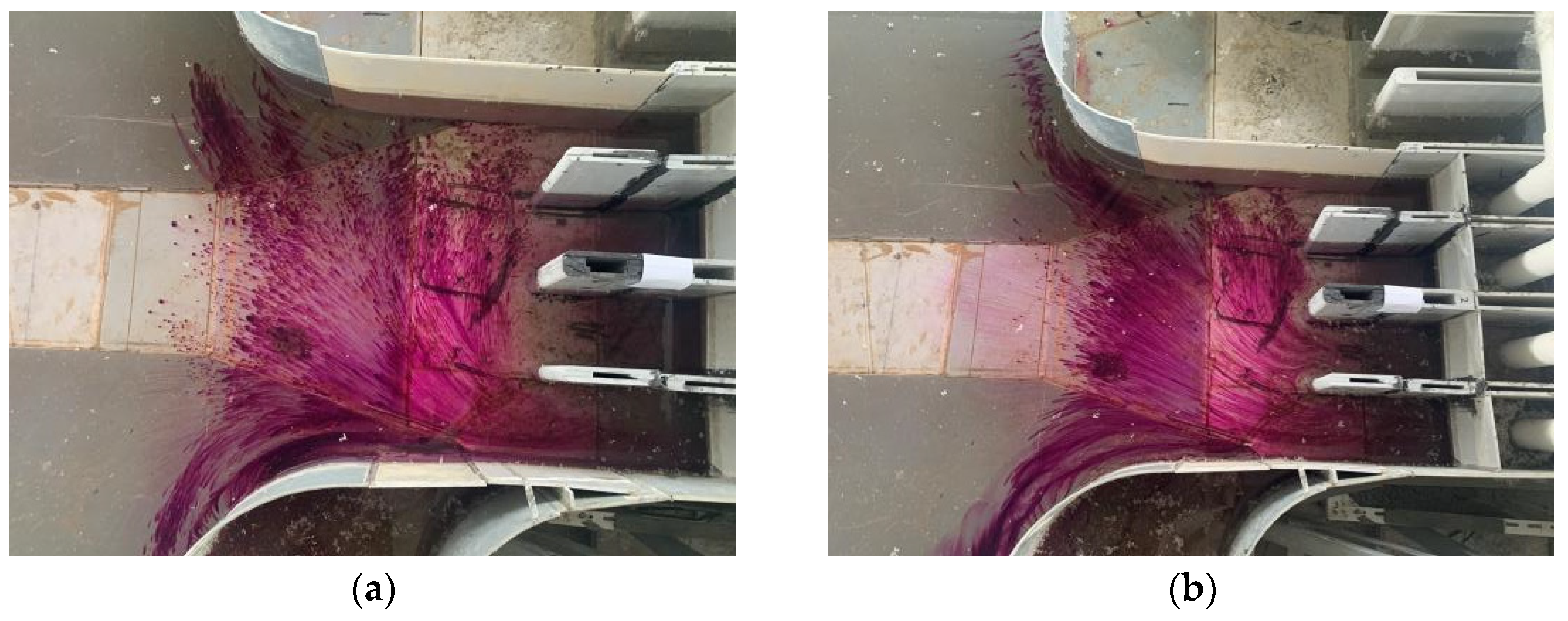
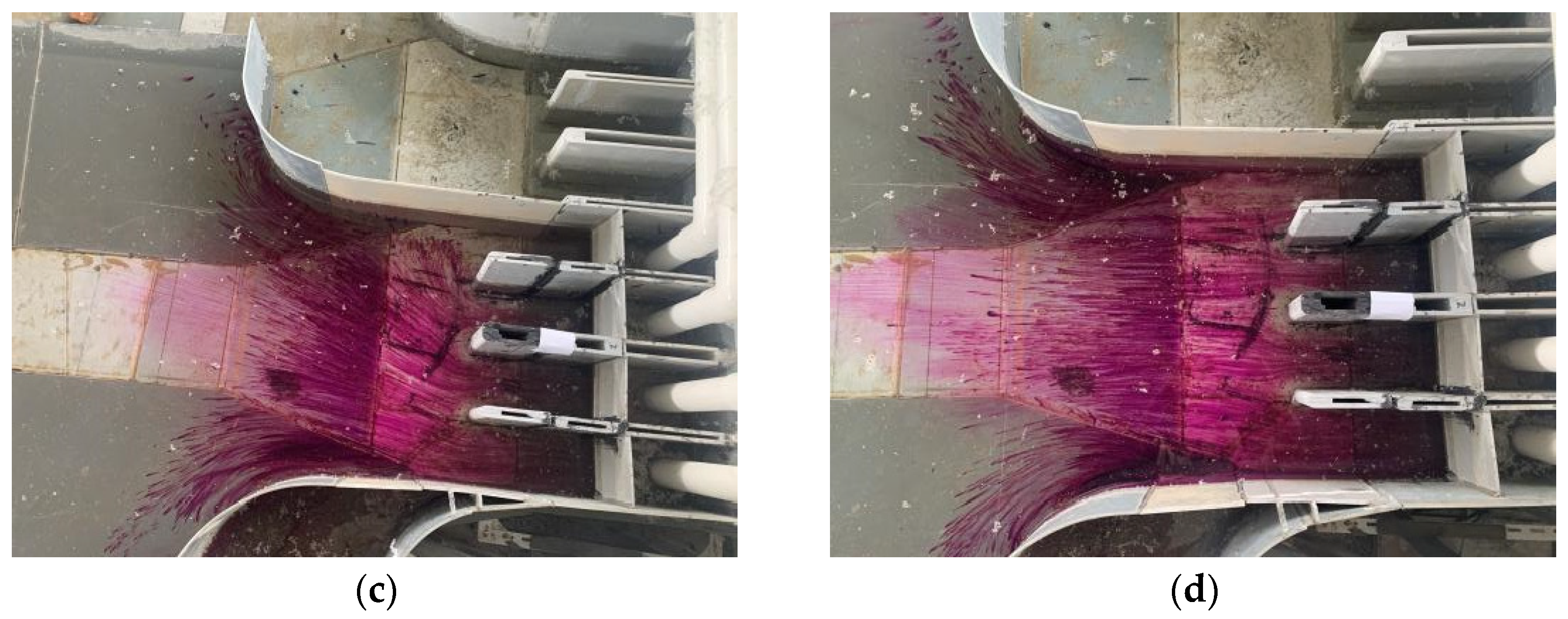
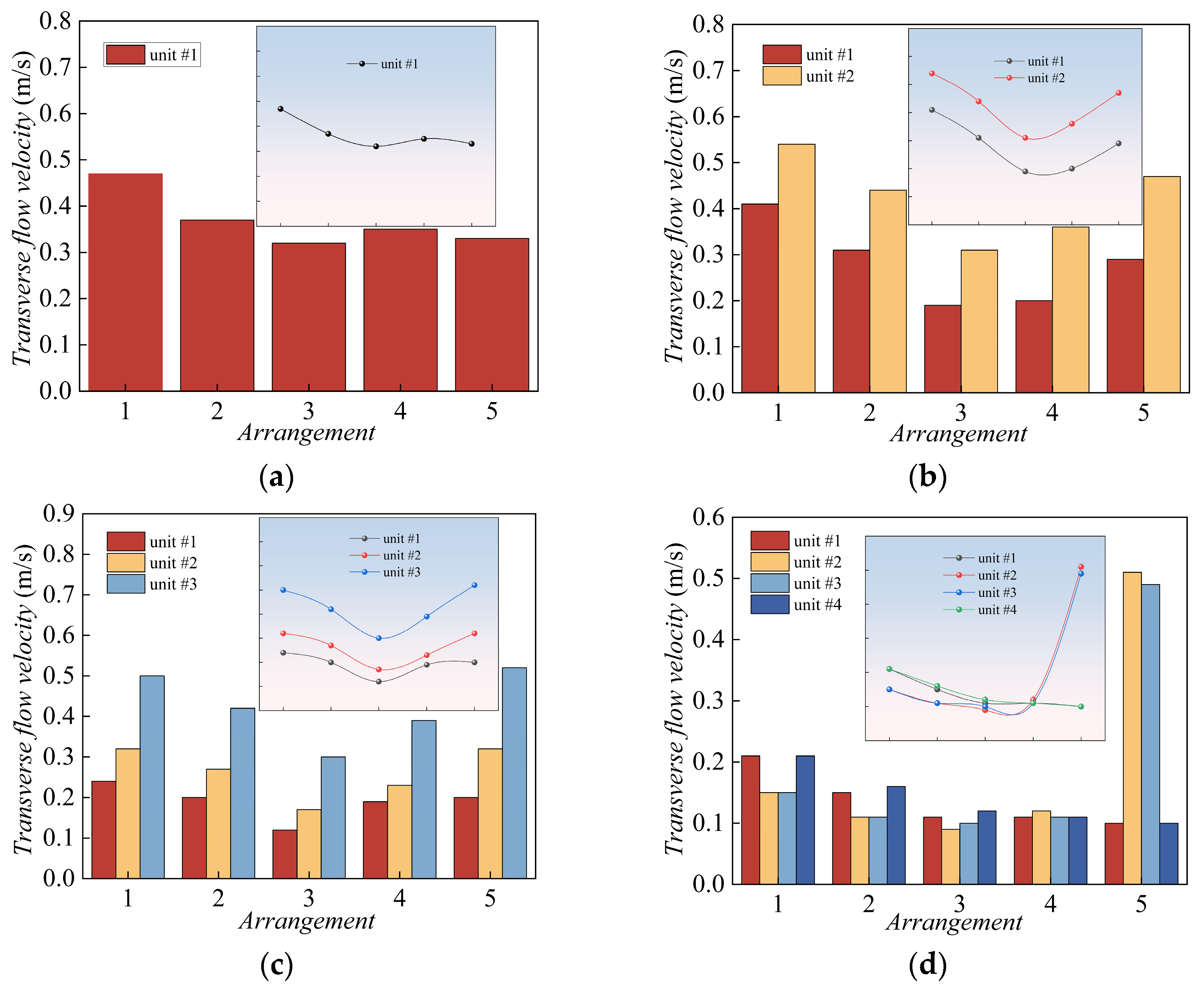
| Name | Symbol | Value |
|---|---|---|
| Number of units | Zl | 4 |
| Design flow | Qd | 33.5 m3/s |
| Total design flow | Qt | 134.0 m3/s |
| Forebay slope ratio | αk | 1:8 |
| Minimum operating water level | Hmin | 19.1 m |
| Unit 1 | Unit 2 | Unit 3 | Unit 4 | |
|---|---|---|---|---|
| Operating condition 1 | on | off | off | off |
| Operating condition 2 | on | on | off | off |
| Operating condition 3 | on | on | on | off |
| Operating condition 4 | on | on | on | on |
| Name | Symbol | Value |
|---|---|---|
| Geometric scale of model | λr | 50 |
| Number of units | Zm | 4 |
| Model design flow | Qd | 20.4 m3/h |
| Total model design flow | Qt | 81.6 m3/h |
| Channel inlet submerged depth | Hy | 1.5 cm |
| Items | Calculation Settings |
|---|---|
| Pressure term | SIMPLEC |
| Other discrete terms | Second-order upwind |
| Turbulent kinetic energy equation | First-order upwind |
| Dissipation rate equation | First-order upwind |
| Wall condition | Non-slip wall |
| Inlet boundary condition | Velocity inlet |
| Outlet boundary condition | Outflow |
| Convergence accuracy | 10−5 |
| Unit Number | Numerical Simulation (%) | Model Test (%) | Relative Error (%) | |
|---|---|---|---|---|
| Operating condition 1 | #1 | 42.5 | 36.4 | 6.1 |
| Operating condition 2 | #1 | 66.7 | 59.7 | 7.0 |
| #2 | 51.7 | 45.6 | 6.1 | |
| Operating condition 3 | #1 | 55.6 | 50.0 | 5.6 |
| #2 | 55.3 | 50.4 | 4.9 | |
| #3 | 45.3 | 41.2 | 4.1 | |
| Operating condition 4 | #1 | 35.6 | 40.3 | 5.3 |
| #2 | 42.9 | 40.0 | 2.9 | |
| #3 | 44.7 | 41.2 | 3.5 | |
| #4 | 35.0 | 39.4 | 4.4 |
Disclaimer/Publisher’s Note: The statements, opinions and data contained in all publications are solely those of the individual author(s) and contributor(s) and not of MDPI and/or the editor(s). MDPI and/or the editor(s) disclaim responsibility for any injury to people or property resulting from any ideas, methods, instructions or products referred to in the content. |
© 2025 by the authors. Licensee MDPI, Basel, Switzerland. This article is an open access article distributed under the terms and conditions of the Creative Commons Attribution (CC BY) license (https://creativecommons.org/licenses/by/4.0/).
Share and Cite
Lv, F.; Li, P.; Zhu, B.; Guo, X.; Wang, L.; Xu, L. Study on the Improvement of Coastal Pumping Station Inlet Flow Regime and Evaluation of Transverse Flow Velocity Elimination. J. Mar. Sci. Eng. 2025, 13, 673. https://doi.org/10.3390/jmse13040673
Lv F, Li P, Zhu B, Guo X, Wang L, Xu L. Study on the Improvement of Coastal Pumping Station Inlet Flow Regime and Evaluation of Transverse Flow Velocity Elimination. Journal of Marine Science and Engineering. 2025; 13(4):673. https://doi.org/10.3390/jmse13040673
Chicago/Turabian StyleLv, Fusheng, Pingping Li, Bo Zhu, Xilong Guo, Lei Wang, and Lei Xu. 2025. "Study on the Improvement of Coastal Pumping Station Inlet Flow Regime and Evaluation of Transverse Flow Velocity Elimination" Journal of Marine Science and Engineering 13, no. 4: 673. https://doi.org/10.3390/jmse13040673
APA StyleLv, F., Li, P., Zhu, B., Guo, X., Wang, L., & Xu, L. (2025). Study on the Improvement of Coastal Pumping Station Inlet Flow Regime and Evaluation of Transverse Flow Velocity Elimination. Journal of Marine Science and Engineering, 13(4), 673. https://doi.org/10.3390/jmse13040673






